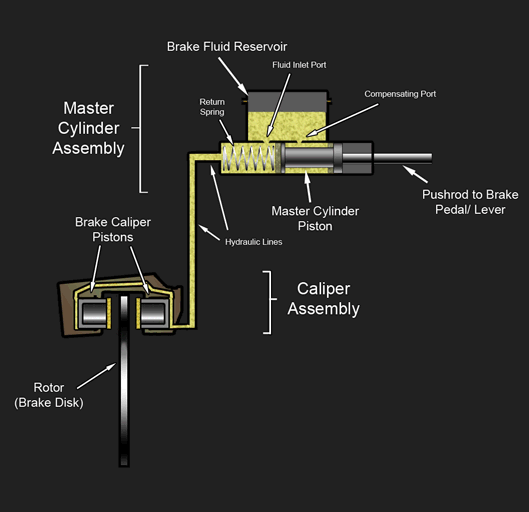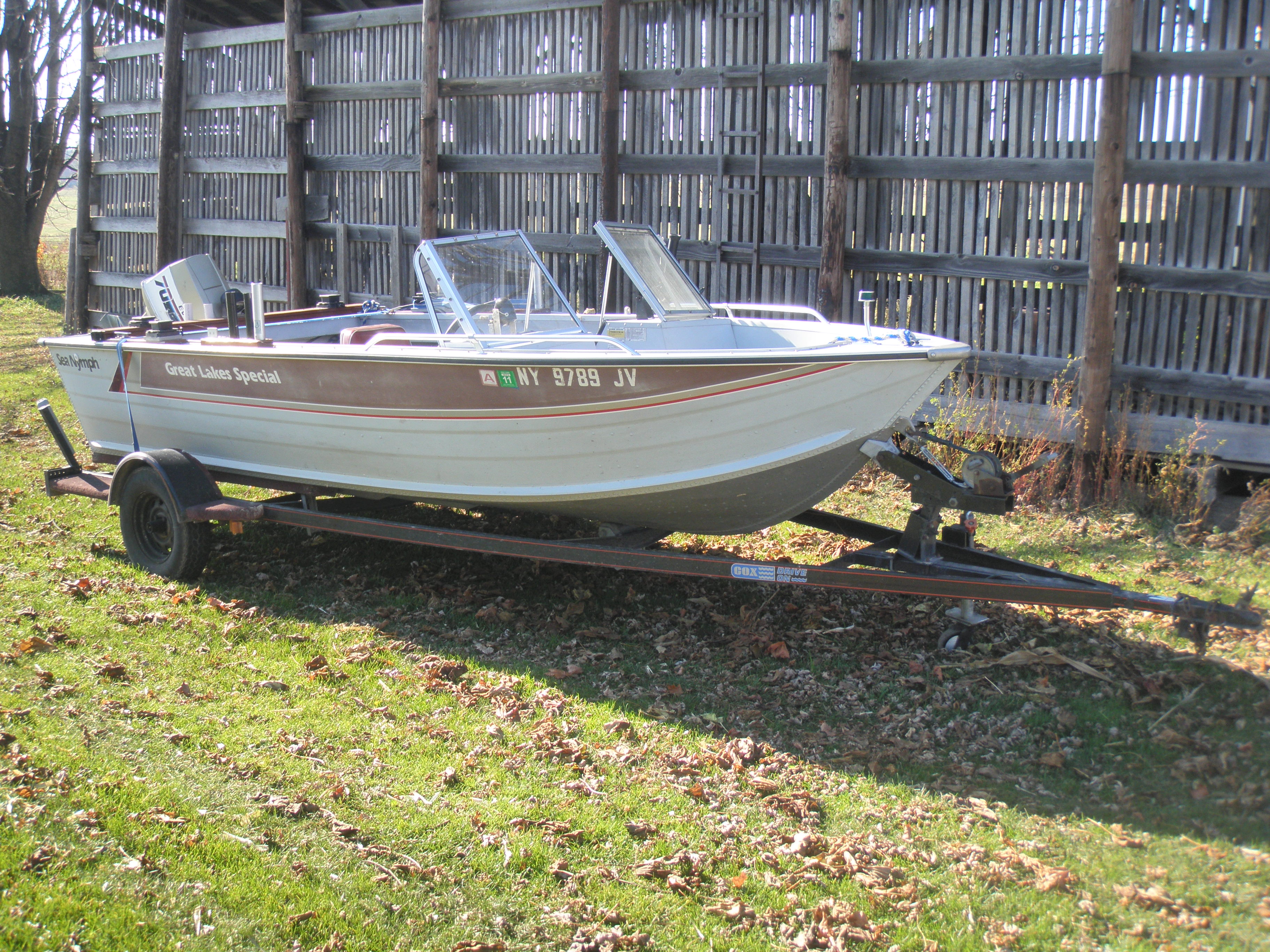|
Overrun Brake
An overrun brake (called a surge brake when invented) is a brake system commonly used on small trailers, where the motion of the trailer with respect to the towing vehicle is used to actuate the brake. The early systems were fitted with a spring system which was not very effective. Later systems were fitted with a sliding mechanism within the coupling, which enables the drawbar to move back and forth relative to the trailer chassis. When the towing vehicle brakes, the inertia of the trailer slides the mechanism, this in turn uses the travel of this mechanism to pull on the brake rod which applies the brakes. The sliding mechanism contains a damper to even out the shock loading transmitted from the tow vehicle. Therefore, the inertia of the trailer provides the force to apply the brakes. Some systems have a ball hitch that is normally straight, but when the lead vehicle starts braking, the trailer pushes forward on the ball hitch, pitching it up which then activates a variable hyd ... [...More Info...] [...Related Items...] OR: [Wikipedia] [Google] [Baidu] |
Brake
A brake is a mechanical device that inhibits motion by absorbing energy from a moving system. It is used for slowing or stopping a moving vehicle, wheel, axle, or to prevent its motion, most often accomplished by means of friction. Background Most brakes commonly use friction between two surfaces pressed together to convert the kinetic energy of the moving object into heat, though other methods of energy conversion may be employed. For example, regenerative braking converts much of the energy to electrical energy, which may be stored for later use. Other methods convert kinetic energy into potential energy in such stored forms as pressurized air or pressurized oil. Eddy current brakes use magnetic fields to convert kinetic energy into electric current in the brake disc, fin, or rail, which is converted into heat. Still other braking methods even transform kinetic energy into different forms, for example by transferring the energy to a rotating flywheel. Brakes are generally ... [...More Info...] [...Related Items...] OR: [Wikipedia] [Google] [Baidu] |
Trailer (vehicle)
A trailer is an unpowered vehicle towed by a powered vehicle. It is commonly used for the transport of goods and materials. Sometimes recreational vehicles, travel trailers, or mobile homes with limited living facilities where people can camp or stay have been referred to as trailers. In earlier days, many such vehicles were towable trailers. United States In the United States, the term is sometimes used interchangeably with travel trailer and mobile home, varieties of trailers and manufactured housing designed for human habitation. Their origins lay in utility trailers built in a similar fashion to horse-drawn wagons. A trailer park is an area where mobile homes are placed for habitation. In the United States trailers ranging in size from single-axle dollies to 6-axle, high, long semi-trailers are commonplace. The latter, when towed as part of a tractor-trailer or "18-wheeler", carries a large percentage of the freight that travels over land in North America. Types ... [...More Info...] [...Related Items...] OR: [Wikipedia] [Google] [Baidu] |
Hydraulic Brake
A hydraulic brake is an arrangement of braking mechanism which uses brake fluid, typically containing glycol ethers or diethylene glycol, to transfer pressure from the controlling mechanism to the braking mechanism. History During 1904, Frederick George Heath (Heath Hydraulic Brake Co., Ltd.), Redditch, England devised and fitted a hydraulic (water/glycerine) brake system to a cycle using a handlebar lever and piston. He obtained patent GB190403651A for “Improvements in hydraulic actuated brakes for cycles and motors”, as well as subsequently for improved flexible rubber hydraulic pipes. In 1908, Ernest Walter Weight of Bristol, England devised and fitted a four-wheel hydraulic (oil) braking system to a motor car. He patented it in Great Britain (GB190800241A) in December 1908, later in Europe and the USA and then exhibited it at the 1909 London Motor Show. His brother, William Herbert Weight improved the patent (GB190921122A) and both were assigned to the Weight Patent Autom ... [...More Info...] [...Related Items...] OR: [Wikipedia] [Google] [Baidu] |
Boat Trailer
A boat trailer is designed to launch, retrieve, carry and sometimes store boats. Commercial boat trailers Commercial hydraulic boat trailers are used by marinas, boat yards, boat haulers, boat dealers and boat builders. Generally this type of trailer is not used for storage of the boat. Self-propelled Self-propelled boat movers are not strictly trailers, but hydraulically operated boat movers, with their own tractor unit. They share all of the features of hydraulic boat trailers. Non-commercial boat trailers This type of trailer is usually used by the boat owner/operator. The trailer is also used for storage. * Roll-on, also known as a "Roller style trailer", uses rubber and/or polyurethane rollers for ease of launching and loading a boat. * Glide-path, also known as a "Float-on style trailer", allows the boat to float onto the trailer; after the trailer has been partially submerged (usually of the trailer). Since its inception, it has become quite popular compared to th ... [...More Info...] [...Related Items...] OR: [Wikipedia] [Google] [Baidu] |
Electric Friction Brake
An electric friction brake, often referred to as just electric brake or electric trailer brake, is a brake controlled by an electric current and can be seen on medium duty trailers like caravans/RVs and consumer-grade car trailers. It is related to the electromagnetic track brake used in railways which also use electric current to directly control the brake force. Mechanical principle This describes the electrically controlled drum brake principles. The brake is built with the brake shield (1) as a base that contains the mechanism. The brake shield is mounted on an axle/spindle using the holes in the centre. The brake shoes (3) are the items performing the braking by pressing outwards at the drum that covers all the innards. The brake shoes are held in place by reactor springs (2) and an adjuster (7) spring. There are also some minor clips not pictured to keep the brake shoes in place. Braking starts with applying a current proportional to the desired brake force to the e ... [...More Info...] [...Related Items...] OR: [Wikipedia] [Google] [Baidu] |
Freewheel
Freewheel mechanism In mechanical or automotive engineering, a freewheel or overrunning clutch is a device in a transmission that disengages the driveshaft from the driven shaft when the driven shaft rotates faster than the driveshaft. An overdrive is sometimes mistakenly called a freewheel, but is otherwise unrelated. The condition of a driven shaft spinning faster than its driveshaft exists in most bicycles when the rider stops pedaling. In a fixed-gear bicycle, without a freewheel, the rear wheel drives the pedals around. An analogous condition exists in an automobile with a manual transmission going downhill, or any situation where the driver takes their foot off the gas pedal, closing the throttle: the wheels drive the engine, possibly at a higher RPM. In a two-stroke engine, this can be catastrophic—as many two stroke engines depend on a fuel/oil mixture for lubrication, a shortage of fuel to the engine starves oil from the cylinders, and the pistons can soon seize, ... [...More Info...] [...Related Items...] OR: [Wikipedia] [Google] [Baidu] |
Brakes
A brake is a mechanical device that inhibits motion by absorbing energy from a moving system. It is used for slowing or stopping a moving vehicle, wheel, axle, or to prevent its motion, most often accomplished by means of friction. Background Most brakes commonly use friction between two surfaces pressed together to convert the kinetic energy of the moving object into heat, though other methods of energy conversion may be employed. For example, regenerative braking converts much of the energy to electrical energy, which may be stored for later use. Other methods convert kinetic energy into potential energy in such stored forms as pressurized air or pressurized oil. Eddy current brakes use magnetic fields to convert kinetic energy into electric current in the brake disc, fin, or rail, which is converted into heat. Still other braking methods even transform kinetic energy into different forms, for example by transferring the energy to a rotating flywheel. Brakes are generally ... [...More Info...] [...Related Items...] OR: [Wikipedia] [Google] [Baidu] |




